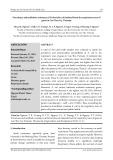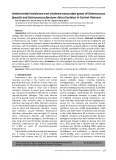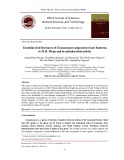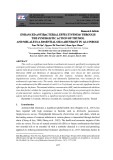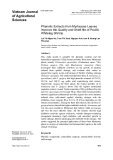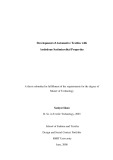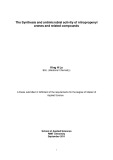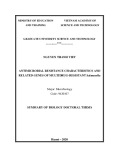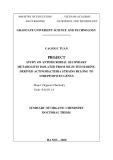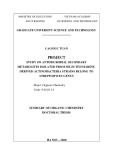Eur. J. Biochem. 269, 347–357 (2002) (cid:211) FEBS 2002
A b-lysine adenylating enzyme and a b-lysine binding protein involved in poly b-lysine chain assembly in nourseothricin synthesis in Streptomycesnoursei
Nicolas Grammel1,*, Kvitka Pankevych2, Julia Demydchuk2, Klaus Lambrecht2, Hans-Peter Saluz2, Ullrich Keller1 and Hans Kru¨ gel2
1Max-Volmer-Institut fu¨r Biophysikalische Chemie und Biochemie, Fachgebiet Biochemie und Molekulare Biologie, Technische Universita¨t Berlin, Germany; 2Department of Cell and Molecular Biology, Hans Kno¨ll Institute for Natural Product Research, Jena, Germany
64 100 which can be loaded by NpsA with b-lysine as a thioester. Analysis of the deduced amino-acid sequence from the gene (npsB) of NpsB showed that it consists of two domains. The N-terminal domain of (cid:25) 100 amino-acid res- idues has high similarity to PCP domains of NRPSs whereas the 450-amino-acid C-terminal domain has a high similarity to epimerization (E)-domains of NRPSs. Remarkably, in this E-domain the conserved H-H-motif is changed to H-Q, which suggests that either the domain is nonfunctional or has a specialized function. The presence of one single adenylating b-lysine activating enzyme in nourseothricin-producing streptomycete and a separate binding protein suggests an iteratively operating NRPS-module catalyses synthesis of the poly b-lysine chain.
Keywords: nonribosomal peptide synthetase; PCP-domain, b-lysine, nourseothricin, Streptomyces.
Nourseothricins (syn. Streptothricins), a group of nucleoside peptides produced by several streptomycete strains, contain a poly b-lysine chain of variable length attached in amide linkage to the amino sugar moiety gulosamine of the nucleoside portion. We show that the nourseothricin-pro- ducing Streptomyces noursei contains an enzyme (NpsA) of an apparent Mr 56 000 that specifically activates b-lysine by adenylation but does not bind to it as a thioester. Cloning and sequencing of npsA from S. noursei including its flank- ing DNA regions revealed that it is closely linked to the nourseothricin resistance gene nat1 and some other genes on the chromosome possibly involved in nourseothricin bio- synthesis. The deduced amino-acid sequence revealed that NpsA is a stand-alone adenylation domain with similarity to the adenylation domains of nonribosomal peptide synthe- tases (NRPS). Further analysis revealed that S. noursei contains a b-lysine binding enzyme (NpsB) of about Mr
b-lysine chains. Streptothricins are potent inhibitors of prokaryotic protein biosynthesis, but are not used thera- peutically due to their nephrotoxicity [2]. Nourseothricin is currently being used under the name CloNat, and is an effective selective agent for molecular cloning technologies in fungi and plants [3–6]. On the other hand, streptothricins are also being tested as fungistatics in agriculture for the treatment of blast disease and other plant diseases [7].
The nourseothricins belong to the family of the streptothri- cin antibiotics that are produced by various streptomycete strains such as Streptomyces noursei [1]. These compounds are nucleoside peptides containing a carbamido-D-gulos- amine core, to which a poly b-lysine chain and the unusual amino acid streptolydine are attached in amide and N-glycosidic linkages, respectively (Fig. 1). The various members of the group differ in the length of their poly
Knowledge of the biosynthesis of streptothricins mainly stems from in vivo precursor studies (Fig. 1; reviewed in [8]). Thus, streptolydine is derived from arginine [9], gulosamine from glucosamine [10], and b-lysine from a-lysine [11]. As the nourseothricins combine the struc- tural features of peptides and nucleosides, their biosyn- thesis involves quite diverse enzyme activities for sugar biosynthesis, peptide bond formation, glycosylation and the formation of the nourseothricin precursors such as b-lysine and streptolydine. The poly (b-lysine) chains of nourseothricins are unique structures as they are made up from identical (b-lysine) amino-acid residues connected to each other with e-(b-lysyl)-peptide bonds and with the chain attached to the amino group of the gulosamine moiety. Peptide bond formation in natural products is often catalysed by nonribosomal peptide synthetases (NRPSs), a family of highly conserved enzymes, which are composed of modules each responsible for the activation and incorporation of always one individual
Correspondence to H. Kru¨ gel, Department of Cell and Molecular Biology, Hans Kno¨ ll Institute for Natural Product Research, Beutenbergstraße 11, D-07745 Jena, Germany, Fax: + 49 3641 656694, Tel.: + 49 3641 656684, E-mail: hkruegel@pmail.hki-jena.de, or U. Keller, Max-Volmer- Institut fu¨ r Biophysikalische Chemie und Biochemie, Fachgebiet Biochemie und Molekulare Biologie, Techni- sche Universita¨ t Berlin, Franklinstrasse 29, D-10587 Berlin, Germany. Tel.: + 49 30 314 25653, E-mail: Ullrich.Keller@TU-Berlin.de Abbreviations: NRPS, nonribosomal peptide synthetase; A-domain, adenylation domain; PCP-domain, peptidyl carrier domain; C-domain, condensation domain; 4¢-Ppan, 4¢-phosphopanthetheine; E-domain, epimerization domain; M-domain, methylation domain. *Present address: ActinoDrug Pharmaceuticals GmbH, Hennigsdorf, Germany. (Received 7 June 2001, revised 11 October 2001, accepted 6 November 2001)
348 N. Grammel et al. (Eur. J. Biochem. 269)
(cid:211) FEBS 2002
binding of the substrate to the enzyme. This differs from the nonribosomal thiol template mechanism [17].
On the other hand, gene disruption experiments in streptothricin-producing S. rochei revealed a gene locus involved in streptothricin biosynthesis with five genes including one encoding resistance against the antibiotic [18]. One of the ORFs encodes a protein with similarity to the adenylation domains of peptide synthetases. This points to nonribosomal mechanisms of streptothricin biosynthesis. However, from the data it was not clear which substrate the enzyme would activate: b-lysine or streptolydine, the latter containing an internal peptide bond.
amino acid into a given peptide product [12,13]. The sequential order and number of the various modules of a NRPS system determines the sequence and the length of the peptide product. The modules consist of domains including the adenylation domain (A-domain) responsible for amino-acid recognition and their activation as an aminoacyl adenylate, and the peptidyl carrier domain (PCP-domain or T-domain) C-terminal to the A-domain providing a covalently bound 4¢-phosphopanthetheine (4¢-Ppan) cofactor for thioester binding of amino-acid substrates and of peptidyl intermediates [14]. The third essential domain of a module is the condensation domain (C-domain) located aminoterminally to the adenylation domain which catalyses condensation of amino acid thioester attached to adjacent modules. Besides the minimal set of A, T and C domains, modules of NRPS may also harbour epimerization (E) domains, methylation (M) domains, cyclization (Cy) domains instead of the C domain, oxygenation (Ox) domains or reduction (Red) domains. These catalyse modification reactions on amino acids or peptidyl intermediates [15].
To clarify the mechanism of poly b-lysine synthesis during nourseothricin synthesis we set out to isolate the hypothetical poly b-lysine synthetase or its NRPS equiva- lent from S. noursei and to clone the gene. We found that S. noursei contains a stand-alone A-domain that activates b-lysine by adenylation. It was also found that S. noursei harbours a protein that after activation specifically binds b-lysine as a thioester. This protein contains a PCP-domain and a second domain with strong similarity to E-domains of peptide synthetases, which indicates that the poly b-lysine chain of nourseothricins is synthesized by a thiol template mechanism.
Fig. 1. Structure of nourseothricin and its biosynthetic precursors.
M A T E R I A L S A N D M E T H O D S
Strains and their cultivation
S. noursei JA3890b was from the strain collection of the Hans Knoell Institute [19]. The strain was maintained on agar slants and cultivated in submerged cultures in medium M79 [20]. Mycelia for enzyme preparations were harvested from cultures propagated in 500 mL conical flasks contain- ing 100 mL medium at 28 (cid:176)C for 2–3 days. The cultures were cooled on ice, the mycelia were collected by centri- fugation at 4 (cid:176)C, washed in 0.9% NaCl solution and stored at ) 80 (cid:176)C until use. S. lividans 1326, from the John Innes Collection, was maintained and cultivated as described previously [21].
The fact that the poly b-lysine chains of the different nourseothricins consist of identical residues raises the question as to whether the residues are incorporated by a modular peptide synthetase containing several distinct b-lysine modules or whether there is only one module condensing the various b-lysine residues iteratively. Another question is how the b-lysines are added to the gulosamine moiety. By analogy to some poly amino acids such as folyl- poly c-glutamate, an amino-acid polymer produced by bacteria and eukaryotes [16], poly b-lysine synthesis could possibly occur by a mechanism involving activation as b-lysyl phosphate and subsequent ligation of b-lysine residues in an iterative fashion. Thus, the condensing enzyme would belong to the ADP-forming amide bond ligase superfamily containing enzymes such as folyl-poly c-glutamate synthetase, UDP-N-acetyl-muramoyl-L-ala- nine-glutamate ligase, glutathione synthetase or D-Ala-D- Ala ligase. All of these condense carboxylate-containing compounds with a free amino group without covalent
(cid:211) FEBS 2002
Poly b-lysine assembly in S. noursei (Eur. J. Biochem. 269) 349
Chemicals and radiochemicals
1
2
b-Lysine was kindly provided by U. Graefe, Hans Knoll and by P. A. Frey, University of Wisconsin, Institute [3H]b-Lysine (220 CiÆmmol)1) was Madison, WI, USA. obtained from Hartmann Analytik, GMbH, Braunschweig, . [32P]Tetrasodium pyrophosphate (17.8 CiÆmol)1) Germany was from New England Nuclear (NEN). Streptolydine- gulosamine was obatined by partial hydrolysis of nourseo- thricin according to the previously described method [22]. The compound was characterized as described previously the highest purity [23]. All other chemicals were of commercially available.
Purification of b-lysine activating enzyme
The pooled enzyme was applied onto an anion exchange column (Mono Q HR5/5, Pharmacia) equilibrated in buffer B and was eluted with a linear gradient from 0 to 0.2 M NaCl in buffer B (flow rate 1 mLÆmin)1, gradient 60 min). Fractions containing enzyme activity were pooled and saturated ammonium sulphate solution was added to a final concentration of 10%. The mixture was applied onto a phenyl Superose HR5/5 (Pharmacia) column equilibrated with buffer B containing ammonium sulfate at 10% saturation. The column was eluted with a descending gradient of 10 to 0% ammonium sulphate (flow rate 0.5 mLÆmin)1, 45 mL total volume). The b-lysine-activating enzyme eluted at an ammonium sulphate concentration corresponding to 8–9% saturation. Fractions containing enzyme were pooled and concentrated in a microconcen- trator (Centricon 30, Amicon).
3
Concentrated enzyme was subjected to gel filtration chromatography (Superose 12 HR 10/30 column, Pharma- cia) using a Smart chromatography system (Pharmacia). The flow rate was 300 lLÆmin)1 and 200 lL fractions were collected (Fig. 2). Active fractions were subjected to SDS/ PAGE. After staining, the protein band corresponding to the enzyme was isolated for further analysis.
Purification of the b-lysine binding protein
4
All operations were carried out at 4 (cid:176)C in a cold room. S. noursei mycelia (50 g) were suspended in 200 mL buffer B and passed through a French pressure cell at 68 947 kPa. The resultant homogenate was treated with (cid:25) 50 lgÆmL)1 DNAse I (grade II, Sigma) in the presence of 20 mM MgCl2 for 1 h. After centrifugation at 30 600 g for 30 min, the supernatant was applied onto a Q-Sepharose FF column (column dimensions 10 · 3 cm) previously equilibrated with buffer B (see below). After washing the column with 50 mL of buffer B, the enzyme was eluted with a 200-mL linear gradient from 0 to 0.2 M NaCl in buffer B (5 mL fractions). Fractions with b-lysine-dependent ATP-pyro- phosphate exchange activity were pooled and saturated ammonium sulphate was added up to a final saturation of 66%. The solution was then left on ice for at least 2 h. The resulting suspension was centrifuged as above, the pellet was dissolved in buffer B and applied to a HiLoad 26/60 Superdex 75 pg column (Pharmacia), which had been previously equilibrated with buffer B. The flow rate was 1 mLÆmin)1 and the fraction size was 1 mL. Fractions containing b-lysine activating activity were pooled.
All operations were carried out in a cold room. S. noursei mycelia (40 g) suspended in 200 mL of buffer B was passed through a French pressure cell at 68 947 kPa. DNAse I (grade II, Sigma) was added at 50 lgÆL)1 and MgCl2 at 20 mM and left on ice with stirring for 1 h. After centri- fugation for 20 min at 30 600 g , the supernatant was adjusted to a conductivity of 4 mS with water (containing 10 mM dithioerythritol) and applied onto a Q-Sepharose FF column (column dimension 10 cm · 3 cm) pre-equilibrated with buffer B. After washing the column with 100 mL of buffer B a linear gradient (total volume 200 mL) of 0–0.2 M
Fig. 2. Identification of NpsA by gel filtration of b-lysine activating enzyme on Superose 12. Concentrated enzyme (300 lL) from the phenlysuperose step of Table 1 were applied onto a Superose 12 column (Pharmacia). 300 lL fractions were collected. The frac- tionation range from fraction 35–55 is shown. (3/4) Absorbance at 280 nm; (bars) activity pattern of the b-lysine-dependent ATP/PPi exchange. The inset shows SDS/PAGE (10% polyacrylamide, according to [22]) of 30 lL portions of the indicated fractions. Staining was with Coomassie blue. The band repre- senting the b-lysine activating enzyme NpsA is denoted by an arrow.
350 N. Grammel et al. (Eur. J. Biochem. 269)
(cid:211) FEBS 2002
Buffers and solvent systems
NaCl was passed through the column and 5-mL fractions were collected.
Buffer B contained 0.1 M Tris/HCl, pH 8.0, 4 mM dithio- erythritol, 1 mM benzamidine, 1 mM phenylmethylsulfonyl fluoride, 2 mM EDTA. Buffer C was the same as buffer B except that it contained 0.05 M Tris/HCl, pH 7.5. Solvent systems for thin layer chromatography of b-lysine were n-butanol/acetic acid/water (4 : 1 : 1,v/v/v;solventsystem I) or isopropanol/acetic acid/water (7 : 3 : 2, v/v/v; solvent system II).
Methods of analysis
Fractions were assayed by determination of covalent binding of [3H]b-lysine to protein in the presence of the b-lysine activating enzyme, ATP and MgCl2 (see below). Fractions containing b-lysine binding activity were pooled and saturated ammonium sulphate solution was added until 70% saturation. After leaving on ice overnight, the suspen- sion was centrifuged as described above. Pelleted protein was dissolved in a small volume of buffer B. The sample was subjected to gel filtration using HiLoad 26/60 Superdex 75 pg column equilibrated with buffer B, and 1-mL fractions were collected. Fractions containing the b-lysine binding protein were combined and subjected to anion exchange chromatography on Resource Q (6 mL column, Pharmacia) equilibrated with buffer B. A 120-mL gradient (flow rate 2 mLÆmin)1) was applied and 2 mL fractions were collected.
Protein concentrations were determined according to Bradford [26]. SDS/PAGE was carried out according to Laemmli [27]. Staining of gels was according to standard procedures. Radioactivity determinations were by scintilla- tion counting with a scintillation cocktail (Quicksafe A, Zinsser Analytic) [25]. Thin-layer chromatograms (Silica gel 60, Merck, Darmstadt) were autoradiographed by exposure to Kodak X-ray film (Biomax MS). b-Lysyl thioester was analysed by performic acid treatment of trichloroacetic acid precipitated enzyme thioester as described previously [25].
Protein sequence determinations
The active fractions were pooled and brought to 20% ammonium sulfate saturation. The solution was applied onto a phenyl Superose HR5/5 (Pharmacia) column equilibrated with buffer B containing ammonium sulphate at 20% saturation and the protein was eluted with a 60-mL gradient (flow rate 1 mLÆmin)1) ranging from 20 to 0% ammonium sulphate saturation. The enzyme was eluted at 6% saturation. Active fractions were pooled and concen- trated to a final volume of 200 lL using a Centricon 30 microconcentrator. The sample was then subjected to gel filtration on a Superose 12 HR 10/30 column (Pharmacia) previously equilibrated in buffer C at a flow rate of 200 lLÆmin)1. Fractions (300 lL) were collected and the b-lysine binding protein containing fractions were pooled. Active fractions were subjected to analysis by gel electro- phoresis.
Enzyme assays
Peptide sequences were determined with a Procise peptide Sequencer (Applied Biosystems). Bands from SDS/PAGE separations of the b-lysine activating enzyme blotted onto poly(vinylidene difluoride) membrane were visualized with Ponceau S, cut out and directly sequenced. In the case of the b-lysine binding protein, bands in gels were visualized by Coomassie staining. Gel pieces were cut out and subjected to in-gel digestion with trypsin as described previously [28]. After elution, the tryptic peptide mixture was separated by HPLC (lRPC C2/C18 column, Pharmacia) with acetonit- rile/water gradients in the presence of trifluoroacetic acid. Well resolved peaks were subjected to sequencing. In the case of the b-lysine binding protein six peptide sequences were obtained which were used for the design of various oligonucleotide primers for PCR The pair pcp 15, GAG CACGGCMGRGAGGAGGC/PCP; 6, SGCSARGTG SCCSACSGT gave a clone encoding a partial sequence of NpsB.
DNA manipulations
The ATP-pyrophosphate exchange reaction mixture con- tained 1 mM b-lysine, 2.5 mM ATP, 5 mM MgCl2, 0.1 mM tetrasodium pyrophosphate and 2 · 105 c.p.m. [32P]tetra- sodium pyrophosphate and 10–50 lL of b-lysine activating enzyme fraction in a total volume of 220 lL. The mixture was incubated for 10 min at 28 (cid:176)C and stopped by the addition of 0.5 mL charcoal suspension [24]. After 10 min on ice, the charcoal was collected by suction filtration on glass fiber filters, washed once with 35 mL of water and after drying at 80 (cid:176)C (1 h), the filters were counted in a liquid scintillation counter. Specific activity is defined as nkatal, the amount of enzyme catalysing the incorporation of 1 nmol pyrophosphate into ATP per second in the presence of b-lysine.
The b-lysine binding protein was assayed in a coupled assay with the b-lysine activating enzyme. The assay contained 1–2 pkatal of b-lysine activating enzyme, 0.1 mM b-lysine, 0.1 lCi [3H]b-lysine, 18 mM ATP, 33 mM MgCl2 and 5–25 lL of b-lysine binding protein fraction in a total volume of 60 lL. After 30 min of incubation at 28 (cid:176)C, 2 mL 7% trichloroacetic acid was added. The mixture was left on ice for 30 min The precipitated protein was collected on membrane filters (ME 30, Schleicher & Schuell), washed with 35 mL of water and after drying, radioactivity was counted in a liquid scintillation counter [25].
All DNA manipulations were performed according to published procedures [29]. In particular, genomic DNA of S. noursei was prepared from lysozyme-digested mycelium by phenol/chloroform purification as described previously [21]. To construct a genomic library, the DNA was partially digested with Sau3A. DNA fragments in the size range from 10 to 20 kb were ligated to BamHI-cleaved lambda phage vector arms (Lambda GEM-11 Packagene system, Pro- mega). Screening for recombinant phages carrying nour- seothricin biosynthesis genes was initially carried out by hybridization of plaques with the nourseothricin resistance gene nat1 [4–6], and in the later course of this work, a fragment of the b-lysine-binding enzyme gene was used. The latter fragment had been generated by PCR from chromo- somal DNA of S. noursei using primers derived from two internal peptide sequences of the b-lysine binding protein.
(cid:211) FEBS 2002
Poly b-lysine assembly in S. noursei (Eur. J. Biochem. 269) 351
activity could be correlated with the intensity of a particular band of 56 kDa (Fig. 2). The enzyme was named NpsA (nourseothricin peptide synthetase A). Microsequencing of this band yielded the N-terminal sequence: MESS ASSFLEPFFDVXR.
The labelling of the probes was with the digoxiginen- labelling kit from Boehringer, Mannheim. Hybridizing plaques were picked, purified and analysed by restriction mapping and hybridization along with chromosomal DNA as control. From each screening, one representative phage (phage ph1-2 and phage ph41, respectively) was chosen for subclone preparation using pUC118 or pBlueScriptKS. Sequencing was performed on a LiCor automated system.
Characterization of the b-lysine activating enzyme (NpsA) from S.noursei
Plasmids
The plasmid for expression of npsA was pDW5 (K. Weber, J. Demydchuk, U. Peschke, unpublished results). Plasmids for subcloning and sequencing were pUC118 and pBlue- ScriptKS.
Nucleotide sequence accession number
Passing NpsA through a calibrated Superdex 75 pg gel filtration column revealed that the enzyme has an Mr between 58 000 and 60 000. This fitted with the estimated molecular mass of NpsA in its denatured form (Fig. 2) and also indicates that the native form of the enzyme is a monomer. The purified enzyme when incubated with tritium-labelled b-lysine, ATP and MgCl2 did not bind the labelled amino acid covalently, which indicates that the enzyme most probably represented a stand-alone A-domain without a PCP-domain.
The DNA sequence data have been deposited in the EMBL nucleotide sequence database under accession nos. AJ315729 (npsA) and AJ315730 (npsB).
R E S U L T S
b-Lysine activation in S.noursei
The enzyme’s substrate specificity was determined by measuring the ATP/pyrophosphate exchange in the pres- ence of different amino acids structurally related to b-lysine. The enzyme did not activate a-lysine or arginine (b-arginine not tested). This indicates that the active site of the enzyme can strictly distinguish between an a-amino and a b-amino group of lysine. Other b-amino acids such as b-alanine or b-aminobutyric acid, c-aminobutyric acid and e-amino caproic acid were not activated. Thus, the activating enzyme appears to be strictly specific for b-lysine. The strict specificity of the enzyme for b-lysine strongly suggests that it is part of the nourseothricin synthesizing enzyme system. No other b-lysine activating enzymes were detected in S. noursei.
Cloning of the NpsAgene
Peptide synthetases activate their amino-acid substrates by adenylation with subsequent covalent binding to a PCP via a thioester linkage. To seek b-lysine adenylating activity possibly involved in nourseothricin biosynthesis, protein extracts of S. noursei actively synthesizing nourseothricin were fractionated by anion exchange chromatography on Q-Sepharose FF matrix (Pharmacia). Assay of fractions from such separations for b-lysine-dependent ATP-pyro- phosphate exchange revealed a single peak of enzyme activity (not shown). The enzyme was further purified by gel filtration on Superdex 75 pg, anion exchange chromato- graphy on Mono Q HR5/5 and hydrophobic chromatog- raphy on phenyl Superose. In all these separations the activity was found in one single peak. The final purification was 50-fold (Table 1).
SDS/PAGE analysis of enzyme from the last purification step revealed several other protein bands (not shown). As further attempts to purify the enzyme activity to homoge- neity failed, we subjected the enzyme from the phenyl Superose step to gel filtration on Superose 12 HR. The activity of each fraction was determined and each fraction was subjected to SDS/PAGE analysis. By this procedure,
Phages ph41 and phN6 are overlapping clones obtained from screening of a phage library of S. noursei DNA using the nourseothricin resistance gene nat1 as a probe (Fig. 3). nat1 has been previously cloned from S. noursei by its property to confer resistance to nourseothricin in foreign streptomycetes [4]. The gene encodes a nourseothricin- acetylase (NatI) which specifically monoacetylates the b-lysine chain of nourseothricin which makes this com- pound antibiotically inactive. It is known that most, if not all, antibiotic biosynthesis gene clusters contain resistance genes against their own antibiotic [31]. We therefore concluded that the gene for the b-lysine activating enzyme
Table 1. Purification of the b-lysine activating enzyme NpsA from Streptomyces noursei. Cells (50g) from a 72-h culture of S. noursei was used. Purification was based on ATP-pyrophosphate exchange dependent on the presence of b-lysine. One nkatalÆmol)1 is the amount of enzyme catalysing the exchange of 1 nmol of pyrophosphate into ATP per second. ND, not determined.
Purification step Volume (mL) Protein (mg) Activity (nkatal) Specific activity (pkatalÆmg)1) Yield (%) Purification (fold)
Crude extract Q-Sepharose FF (NH4)2SO4 60% Superdex 75 HR MonoQ Phenylsuperose 120.0 67.0 2.5 8.0 4.0 2.0 1800 101 88 28 4 1.3 ND 4.197 4.047 1.890 1.875 0.750 ND 41.6 46.0 67.5 468.8 577.0 ND 100 96 45 45 18 ND 1.0 1.1 1.6 11.3 50.0
352 N. Grammel et al. (Eur. J. Biochem. 269)
(cid:211) FEBS 2002
11
revealed high similarity with the adenylation domains of various NRPSs. NpsA possesses all the 10 conserved signature sequences A1 to A10 characteristic of the adeny- lation domains of NRPS [15]. Remarkably, the enzyme has 95% amino-acid sequence identity with SttA from the biosynthesis gene cluster of streptothricin in S. rochei, which confirms the previously proposed role of the enzyme as a b-lysine activating enzyme [18].
An alignment of the amino-acid residues of the adenylate binding pocket of NspA as well as of SttA with consensus sequences derived from the relevant binding residues in the amino-acid binding pocket of the phenylalanine A-domain of gramicidin S synthetase [32,33] showed their similarity to the binding pockets of A-domains, which are known to activate positively charged amino acids such as ornithine and lysine. In particular the characteristic Asp in position 239 of NpsA indicated a strong relationship to the lysine-activating
could possibly lie in the same region of the S. noursei chromosome as the resistance gene. Chromosome walking (by subcloning various BamHI or NotI fragments into pBlueScript and subsequent sequencing) on the overlapping region of the DNA inserts of phP41 and phN6 revealed several ORFs in the 3¢ region of nat1 (Fig. 3). One ORF of 1518 bp was interesting because it encoded a hypothetical protein of 506 residues with a deduced Mr of 53 kDa, which is in the range of the estimated molecular mass of NpsA. The deduced N-terminal sequence of this enzyme is identical to the sequence determined by microsequencing of NpsA (see above), which supports that this gene (designated npsA) is the gene encoding the b-lysine activating enzyme. NpsA has a typical Streptomyces codon usage with a strong bias for high G/C content (> 90%) in the third codon positions of the gene. The overall G/C content of the gene is 75%. Analysis of the deduced amino-acid sequence of NpsA
Fig. 3. Map of the sequenced region containing the nourseothricin resistance gene nat1 and the gene npsA encoding the b-lysine activating enzyme NpsA. (A) The region represents the overlapping region of phages phP41 and phN6. Arrowheads indicate the orientation and relative length of the sequenced orfs. Based on the similarities of their deduced amino-acid sequences with proteins in the database, ORFs A–E are proposed to encode proteins with the following functions: ORF A (acylase), ORF B (thioesterase), ORF C (phosphotransferase), ORF D (unknown), ORF E (regulator). The same orfs in a similar arrangement have been shown to be present in a region of the streptothricin biosynthesis gene cluster of S. rochei [27] (B) The strategy of expression cloning of npsA is shown in the lower part B of the figure. The EcoRI fragment was subcloned in pBluescript and cloned as a XbaI–HindIII fragment into plasmid pDW5 as described in the text. Vegp40 denotes the position of the veg promoter of B. subtilis [25].
Table 2. Specificity determining residues in the binding pocket of NpsA. Alignment of the specificity determining residues of NpsA adenylation domain with several adenylation domains activating amino acids with positively charged side chains. NpsA (b-lysine, this work), SttA (adenylating enzyme from S. rochei [27]), BacB_M1 (a-lysine, module 1 of bacitracin synthetase B, accession no. AAC06347), BacB_M2 (a-ornithine, module 2 of bacitracin synthetase B, Acc.No. AAC06347), GrsB_M3 (a-ornithine, module 3 of gramicidin synthetase B, accession no. CAA43838). The specificity conferring residues were aligned according to the method of Stachelhaus et al. [28]
Position in amino-acid binding pocket
234 235 236 239 278 299 301 322 330 331 Enzyme Amino acid
NpsA SttA BacB_M1 BacB_M2 GrsB_M3 b-Lys b-Lys a-Lys a-Orn a-Orn G G F F F D D D D D T T A V V E E E G G G G S E E V V I I I G G G G G T T S S S L L V V L V V C D I
(cid:211) FEBS 2002
Poly b-lysine assembly in S. noursei (Eur. J. Biochem. 269) 353
module of bacitracin synthetase (Table 2). Interestingly, the universally conserved Phe234 of NRPS A-domains is changed into a glycine residue in both NspA and SttA, which may result in a change of conformation of the Asp235 side chain possibly binding the unusual b-amino-acid substrate.
Expression of npsA in S.lividans
5
To confirm the identity of the gene npsA as the gene encoding NpsA, a 3-kb EcoRI fragment from the phage clone ph41 (Fig. 3) encompassing the entire npsA gene was ligated to EcoRI-cleaved Bluescript vector and after excision as a HindIII–XbaI fragment was ligated into HindIII–XbaI- cleaved pDW5, a derivative of pWHM4, under the control of the veg promoter from Bacillus subtilis [34] (Fig. 3). Transformation of S. lividans by the plasmid containing the cloned gene resulted in strain S. lividans W5. Crude extracts of strain W5 were prepared as for S. noursei and fraction- ated on Q-Sepharose FF. Testing the fractions clearly revealed the presence of the b-lysine activating activity of NpsA in this S. lividans strain, which was missing in a control strain containing plasmid pDW5 (not shown). These data unambiguously indicate that the npsA gene encodes the b-lysine activating enzyme NpsA.
6
Detection and purification of a b-lysine binding protein in S.noursei
A prerequisite in peptide bond formation between amino acids in nonribosomal systems is the covalent activation of amino-acid residues as enzyme-linked thioesters [12,13]. As the b-lysine activating enzyme is a stand-alone adenylation domain lacking a PCP-domain, we set out to identify the missing amino acyl or peptidyl carrier protein which would represent the rest of the missing part of the putative b-lysine module.
of a protein that would bind b-lysine covalently after its activation as adenylate by NpsA. Separation of a crude extract of S. noursei on a Q Sepharose FF and testing fractions for covalent binding of radioactive b-lysine in the presence of NpsA and ATP revealed a peak of b-lysine- binding activity. Gel filtration on a Superdex 75 pg column revealed that the binding protein has a surprisingly high Mr ((cid:25) 70 000 Da) which in view of the small sizes of PCP- domains ((cid:25) 100 residues) of NRPS indicates that this protein must be a multimer or must harbour additional functions besides binding b-lysine as a thioester. The b-lysine binding protein eluted independently of the b-lysine activating enzyme from the Q Sepharose FF column which indicates that these two enzymes do not form a stable complex with each other (not shown). To test the nature of the covalent bond between the binding protein and b-lysine, the b-lysine binding protein was charged with radioactive b-lysine and the covalent enzyme–substrate complex was subjected to performic acid oxidation. The radioactive b-lysine released from the enzyme was identified by thin layer chromatography (using solvent systems I and II). Treatment of charged protein with formic acid released no b-lysine indicating that b-lysine is indeed bound to the protein as a thioester. Analysis by SDS/PAGE at each stage of purification (see Materials and Methods) of the b-lysine binding protein revealed enrichment of a prominent band of (cid:25) 70 kDa (Fig. 4A). To identify this band as the b-lysine binding protein, the native enzyme was loaded with radioactive b-lysine in the presence of NpsA and ATP and subjected to SDS/PAGE. Figure 4 shows that the 70-kDa band was specifically labeled with b-lysine. This reaction was ATP-dependent and also dependent on the presence of the b-lysine activating enzyme NpsA. The protein was named NpsB. Attempts to demonstrate the formation of b-lysyl–b-lysine or poly (b-lysine) in incubations containing purified NpsA and NpsB with ATP and [3H]b-lysine failed. No evidence for the formation of such products was obtai- ned either as free or enzyme bound material. Moreover,
Using radiolabelled b-lysine as substrate, we tested fractions of protein extracts from S. noursei for the presence
Fig. 4. Covalent labelling of NpsB with radio- active b-lysine. Partial purified NpsB (phenyl- Superose step, see Materials and methods) was incubated with NpsA, radioactive b-lysine and ATP. The reaction mixtures were incubated at 28 (cid:176)C for 30 min 2 mL 5% trichloroacetic acid was added and precipitated protein was recovered by centrifugation. Protein was sub- jected to SDS/PAGE (10% SDS/polycaryla- mide slab). The gel was subjected to autoradiofluorography using Amplify solu- tion (Amersham) according to the manufac- turer’s instructions. Autofluorography was for 6 weeks. The complete assay mixture con- tained 0.1 mM b-lysine, 0.1 lCi [3H]b-lysine, 18 mM ATP, 33 mM MgCl2, 1 pkatal NpsA and 5 lL phenylsuperose fraction of NpsB (lane A); lane B with omission of NpsA, lane C with omission of ATP, lane D with omission of NpsB. Left panel: Coomassie Blue-stained gel. Right panel: Autofluorograph of same gel.
354 N. Grammel et al. (Eur. J. Biochem. 269)
(cid:211) FEBS 2002
incubation of NpsA and NpsB with ATP, [3H]b-lysine and streptolydine-gulosamine did not lead to detectable synthe- sis of a new compound dependent on streptolydine/gulo- samine. By contrast, the thin layer chromatograms of reaction mixtures showed only formation of a free com- pound during these incubation with an Rf value much this higher than that of b-lysine. The formation of compound was ATP-dependent and strictly dependent on the presence of either NpsA or NpsB. The possibility that this compound must be the spontaneous cyclization product of the b-lysine thioester (cyclo-b-lysine) could not be determined due to the lack of authentic reference material.
Cloning of the gene of the b-lysine binding protein
to discern. Also,
it
the C-5 hydroxyl group of
Total protein from the last purification step of NpsB was subjected to preparative SDS/PAGE and the band repre- senting the b-lysine binding protein was in-gel digested with trypsin. After HPLC separation, six tryptic peptides were sequenced. Each of the resultant sequences was used to design PCR primers for both strands. The primers were used in PCR in all possible combinations to amplify the gene using chromosomal DNA of S. noursei as template. One primer pair (see Materials and methods) yielded a PCR product with sequences corresponding to the amino-acid sequence of the binding protein. This indicates that the clone represents a partial sequence of the gene of the b-lysine binding protein. The PCR fragment was in turn used as a probe in plaque hybridization screening of our S. noursei phage library. From one hybridizing phage, Ph1-2, a 15-kb insert was obtained (not shown). Narrowing down the hybridizing region by restriction mapping and Southern analysis led to the subcloning of a 6.8-kb BamHI fragment, which was partially sequenced. Analysis of the sequence revealed three ORFs as shown in Fig. 5. The central gene encoded a protein with 606 amino acids of a calculated Mr=64 100, which contained all of the six internal sequences obtained from microsequencing of the peptide
fragments, thus confirming that the gene is npsB. Analysis of the deduced amino-acid sequence indicated that the protein is composed of two distinct domains. The first domain located between amino-acid residues 40–120 has similarity with various ACP- and PCP-domains of polyketide synth- ases and peptide synthetases. The invariant serine residue representing the 4¢-phosphopanthetheine attachment site is located at amino-acid position 88. The second domain of NpsB located carboxyterminal to the ACP-domain from amino-acid residues 150–550 has similarity with condensa- tion and epimerization domains of a number of peptide synthetases (Fig. 5). In particular, the sequence from amino- acid residues 286–296 (HQLAFDMVS) is reminiscent of the signature sequences C3 (HHxISDGxS) or E2 (his-motif) (HHxxxDxVSWxIL) of the C-domains and E-domains of various peptide synthetases, respectively [15]. Moreover, in a part of the protein C-terminal to the H-H-motif, all of the five conserved motifs E3 to E7 (in the nomenclature of Konz & Marahiel [15]) of E-domains are present. Interestingly, the second His in the C3 or E2 motifs, which was shown to be critical both for the condensation of amino acids in C-domains [35] and the epimerization of amino acids in E-domains [36] in NpsB, is replaced by glutamine suggesting a natural mutation from His to Gln in that sequence. As the configuration of the b-lysine residues in nourseothricin is L and the b-lysine substrate used here was also in the L configuration (obtained by acid hydrolysis of nourseo- thricin), the function of this epimerization domain is difficult is not known whether H-Q-versions of the E2/C3 signature sequences are func- tionally active. Sequencing of the upstream region of the npsB revealed an ORF encoding a carbamoyltransferase and further upstream an IS-like sequence. The vicinity of a gene encoding a carbamoyltransferase directly relates to the the carbamoyl group at gulosamine of nourseothricin and is a further hint that the cloned region of the S. noursei chromosome with the b-lysine binding protein gene and the carbamoyltransferase
Fig. 5. Map of a 6.8-kB BamHI fragment from the S. noursei chromosome carrying the gene npsB encoding the b-lysine binding protein NpsB. The sequenced region spans from the indicated (asterisk) SalI to the BamHI site on the left border of the fragment. Arrows indi- cate the orientation and relative length of the sequenced orfs. Sequencing revealed the gene npsB (identified by comparison with sequences of tryptic peptides derived from NpsB), an orf (orf1) with a deduced amino-acid sequence showing homology to carbamoyltransferases, and a IS-like sequence. In the lower part of the figure is shown schematically the structure of the NpsB protein with the two-domain arrangement consisting of a PCP-domain and a domain with similarity to E-domains of NRPSs.
(cid:211) FEBS 2002
Poly b-lysine assembly in S. noursei (Eur. J. Biochem. 269) 355
gene are part of the nourseothricin biosynthetic gene cluster.
8 9
It is noteworthy, that no overlapping clones connecting the inserts of phage ph41 and Ph1-2 were found. In fact, the two inserts appear to be located at a distance of more than 20 kb on the chromosome of S. noursei suggesting a separa- tion of the biosynthetic genes in two partial gene clusters.
D I S C U S S I O N
thesis systems, such as of the aryl peptide lactones, the aryl- siderophore peptides or in the case of D-alanyl-lipoteichoic ], where they activate aromatic carboxylic acids acid [39–43 or an amino acid such as alanine as adenylates , which in turn are loaded to specific PCP domains. These PCP- domains are either alone-standing PCPs, as in the biosyn- thesis of actinomycin [39] and D-alanyl-lipoteichoic acid, or they are fused to protein domains catalysing another step of the same pathway as in EntB, the PCP for the 2,3- dihydroxybenzoic acid in enterobactin synthesis [40]. Usu- ally, the PCP-bound carboxylates are condensed with the next amino acids in the biosynthetic sequence by the action of C-domains or Cy-domains forming part of the down- stream module. Cy-domains not only catalyse condensa- tions between serine, threonine or cysteine residues with upstream thioester-activated amino acids but after conden- sation also cyclize their substrate to the corresponding oxazoline and thiazoline, respectively [44].
7
Streptothricins are nucleoside peptides that contain a poly b-lysyl chain which may vary from three to seven residues in length and which is attached to the 2-amino group of the gulosamine moiety of the antibiotic via an amide linkage. As yet, a total cell-free synthesis of nourseothricins has not been accomplished, nor have partial enzyme activities from S. noursei been characterized. The poly(b-lysine) chain is a unique example of a poly amino-acid chain in a secondary metabolite. A number of poly(amino acids) such as folyl- poly c-glutamate play roles in the housekeeping functions of their producer cells and like the muramyl peptide chains, the tripeptide glutathione or the D-Ala-D-Ala dipeptides of the bacterial cell walls are formed by amino-acid ligases such as UDP-N-acetyl-muramoyl-L-alanine-glutamate ligase, gluta- thione synthetase or D-Ala-D-Ala ligase [37]. They condense carboxylate-containing compounds via the intermediacy of acylphosphates as in the case of formation of the D-Ala- D-Ala dipeptide [38]. Remarkably, in several compounds synthesized by this mechanism, unusual peptide bonds sych as the c-glutamyl peptide bond also occur as in the muramyl peptides and glutathione. As in the poly(b-lysyl) chains, the peptide bond is also unusual (x-b-lysyl) and no poly(amino- acid) synthetases operating via the thiol template mecha- nism have been described as yet, but it could not be excluded a priori that poly b-lysyl synthesis would occur via a ligase- like mechanism.
The data presented here, however, show that the poly- (b-lysine) chain of nourseothricin must be synthesized by an NRPS-like system in a mechanism that uses NspA, a stand-alone b-lysine adenylating enzyme (A-domain) and NspB, a b-lysine binding protein consisting of a PCP- domain and a domain with similarity to E-domains of peptide synthetases. NspA is unique because of its extraordinarily exclusive substrate specificity for b-lysine, which contrasts the relaxed specificity of most NRPS. The sequence of NspA is almost identical with that of SttA the enzyme which has been shown previously to be involved in the biosynthesis of streptothricins in S. noursei [18]. The the substrate binding specificity-conferring residues of pocket of NspA (and SstA) display a sequence with similarity to that of domains known to activate ornithine, diaminobutyric acid, hydroxyornithine or lysine but with a substantial change of the highly conserved Phe234 present in all NRPS A-domains into a glycine which may lead to alteration of the overall conformation ofthe active site pocket which may lead to the selective binding of b-lysine to this pocket (Table 2).
For the condensation of the b-lysine residues, covalent attachment to a PCP-domain in thioester linkage appears to be necessary similarly to other NRPS systems. Accordingly, NspA efficiently loads NspB with b-lysine in thioester linkage. Stand-alone adenylation domains in nonribosomal peptide synthesis have been described for various biosyn-
In contrast to these examples, the b-lysine-binding PCP- domain described here is fused to a domain with similarity to the E-domains of NRPS, which suggests a different mechanism. E-domains in NRPS are always located downstream of PCP-domains and catalyse the conversion of the amino acid or peptidyl intermediate tethered to the PCP-domain from the L to the D configuration. In NRPSs which do not epimerize their substrates, C-domains are also always directly located downstream of PCP-domains. The mechanistic basis for both E-domains and C-domains is similar. They both contain a double His-motif (E2 and C3, respectively) from which the second His of the E-domain is postulated to remove a proton either from the a-carbon of the thioester-activated amino acid or peptidyl intermediate leaving a carbanion intermediate ready for attack by a proton in an Sn2 mechanism [44]. In the C3 signature sequence of C-domains, the second His is thought to remove a proton from the amino nitrogen of the acceptor amino- acid in the condensation process [36]. Thus, the significance of the E-domain described here is not clear because the second His in the E2 is missing the motif being changed into a H-Q, which would suggest that the E-domain of NspB would be nonfunctional. On the other hand, Cy-domains that are present in NRPS catalysing the condensation of a serine, threonine or cysteine residue with an upstream residue under subsequent heterocycle formation have a modified His-motif with only one H which leaves the possibility open for a specialized function of the modified E-domain described here. PksF [45] and PpsE [46] encoded by genes from the genomes of B. subtilis and M. tubercu- losis, respectively, are other examples of E-domains in which the second His of the E2-sequence is changed into Q and A, respectively. It has not yet been tested whether these E-domains function as E- or C-domains. Moreover, the modified E2 motif suggests some significance in the light of the fact that in NpsB an epimerization by the established mechanism [36] of proton abstraction from a-carbon would remain undetectable, because the a-carbon of b-lysine is not asymmetric. Thus, if the E-domain of NpsB would have a function in nourseothricin biosynthesis, it could be specu- lated that this enzyme might catalyse b-lysine condensation in conjunction either with a C-domain or condensing enzyme. As yet, we have not been able to demonstrate the formation of a b-lysyl-b-lysine with NpsA and NpsB nor the transfer of b-lysine to gulosamine, which rules out a direct
356 N. Grammel et al. (Eur. J. Biochem. 269)
(cid:211) FEBS 2002
9. Martinkus, K.J., Tann, C.H. & Gould, S.J. (1983) The Biosyn- thesis of the streptolidine moiety in streptothricin F. Tetrahedron 39, 3493–3505.
10. Sawada, Y., Nakashima, S., Taniyama, H. & Inamori, Y. (1977) Biosynthesis of streptothricin antibiotics. III. Incorporation of D-glucosamine into D-gulosamine moiety of racemomycin-A. Chem. Pharm. Bull. 25, 1478–1481.
11. Sawada, Y., Nakashima, S. & Taniyima, H. (1977b) Biosynthesis of streptothricins antibiotics. VI. Mechanism of b-lysine and ist peptide formation. Chem. Pharm. Bull. 25, 3210–3217.
12. von Do¨ hren, H., Keller, U., Vater, J. & Zocher, R. (1997) Mul- tifunctional peptide synthetases. Chem. Rev. 97, 2675–2705. 13. Marahiel, M.A., Stachelhaus, T. & Mootz, H.D. (1997) Modular peptide synthetases involved in nonribosomal peptide synthesis. Chem. Rev. 97, 2651–2673.
14. Stein, T., Vater, J., Kruft, V., Otto, A., Wittmann-Liebold, B., Franke, P., Panico, M., McDowell, R. & Morris, H.R. (1996) The multiple carrier model of nonribosomal peptide biosynthesis at modular multienzymatic templates. J. Biol. Chem. 271, 15428– 15435. 15. Konz, D. & Marahiel, M.A. (1999) How do peptide synthetases generate structural diversity ? Chem. Biol. 6, R39–R48.
function of the E-domain of NspB as a condensing domain. Interestingly, Stachelhaus et al. reported the involvement of the E-domain of GrsA (PheATE) in conjunction with the ProCAT module of GrsB in the condensation of phenyl- alanine with proline [35]. This transfer role was independent from the presence or absence of the second His in the E2-motif of that E-domain. Thus, one has to consider the possibility of an additional factor operating in the conden- sation reaction between the b-lysine residues of the poly- (b-lysine) chain as well as the condensation reaction of carboxyl activated b-lysine with the gulosamine moiety. The fact, that these condensation reactions involve the partici- pation of only one single stand-alone A-domain and a single binding protein NspB points to an iteration of these two proteins in the assembly line of poly b-lysine chains in nourseothricin biosynthesis. This could either take place by the formation of a multimeric complex between the two enzymes or by an iterative mechanism of poly b-lysine chain formation on a single NspA/NspB module. To address these questions as well as the true function of the E-domain of NpsB in the condensation of b-lysine residues with each other and also with the gulosamine moiety of nourseothri- cin, future studies of nourseothricin biosynthesis and the cloning and sequencing of more genes in the cluster and their expression as functional active enzymes will be necessary.
16. Bognar, A.L., Osborne, C., Shane, B., Singer, S.C. & Ferone, R. (1985) Folylpoly-gamma-glutamate synthetase-dihydrofolate syn- thetase. Cloning and high expression of the Escherichia coli folC gene and purification and properties of the gene product. J. Biol. Chem. 260, 5625–5630.
A C K N O W L E D G E M E N T S
17. Sun, X., Bognar, A.L., Baker, E.N. & Smith, C.A. (1998) Struc- tural homologies with ATP- and folate-binding enzymes in the crystal structure of folylpolyglutamate synthetase. Proc. Natl Acad. Sci. USA 95, 6647–6652.
18. Fernandez-Moreno, M.A., Vallin, C. & Malpartida, F. (1997) Streptothricin biosynthesis is catalyzed by enzymes related to nonribosomal peptide bond formation. J. Bacteriol. 179, 6929– 6936. We thank Prof. Perry A. Frey and Prof. Udo Graefe for providing us with b-lysine, Michael Gru¨ n and Kerstin Weber for skilled technical assistance and Prof. Albert Hinnen for his support of this work. We also thank Prof. Jerald C. Ensign and Dr Sandor Biro´ for critical reading of the manuscript.
19. Bradler, G. & Thrum, H. (1963) Nourseothricin A and B, two new antibacterial antibiotics of a Streptomyces noursei variant. Z. Allg. Mikrobiol. 3, 105–112.
R E F E R E N C E S
20. Kru¨ gel, H. & Fiedler, G. (1986) Copy number mutants of the broad-host-range Streptomyces plasmid pMG200. Plasmid 15, 1–7.
1. Bocker, H. & Bergter, F. (1986) Nourseothricin-properties, bio- synthesis, production. Arch. Exp. Veterinarmed. 40, 646–657. 2. Ho(cid:128)mann, H., Ha¨ rtl, A., Bocker, H., Kahnel, H.-J., Hesse, G. & Flemming, J. (1986) Pharmacokinetics of nourseothricin in labo- ratory animals. Arch. Exp. Vet. Med. 40, 699–709.
3. Haupt, I., Thrum, H. & Noack, D. (1986) Self-resistance of the nourseothricin-producing strain Streptomyces noursei. J. Basic Microbiol. 26, 323–328. 21. Hopwood, D.A., Bibb, M.J., Chater, K.F., Kieser, T., Bruton, C.J., Kieser, H.M., Lydiate, D.J., Smith, C.P., Ward, J.M. & Schrempf, H. (1985) Genetic Manipulation of Streptomyces. A Laboratory Manual, The John Innes Foundation, Norwich, UK. 22. Gra¨ fe, U., Reinhardt, G., Bocker, H. & Thrum, H. (1977) Bio- synthesis of streptolidine moiety of streptothricins by Streptomy- ces noursei JA 3890b. J. Antibiot (Tokyo) 30, 106–110.
4. Kru¨ gel, H., Fiedler, G., Gase, K. & Haupt, I. (1989) Streptothricin resistance. In Bioactive Metabolites from Microorganisms (Bushell, M.E. & Gra¨ fe, U., eds), pp. 357–367. Elsevier Science Publishers B.V., Amsterdam. 23. Borders, D.B., Kirby, J.P., Wetzel, E.R., Davies, M.C. & Haus- mann, W.K. (1972) Analytical method for streptothricin-type antibiotics: structure of antibiotic LL-BL136. Antimicrob. Agents Chemother. 1, 403–407.
5. Kru¨ gel, H., Fiedler, G., Haupt, I., Sarfert, E. & Simon, H. (1988) Analysis of the nourseothricin-resistance gene (nat) of Strepto- myces noursei. Gene 62, 209–217.
24. Keller, U., Kleinkauf, H. & Zocher, R. (1984) 4-Methyl-3- hydroxyanthranilic acid (4-MHA) activating enzyme from actinomycin producing Streptomyces chrysomallus. Biochemistry 23, 1479–1484. 25. Keller, U. 6. Kru¨ gel, H., Fiedler, G., Smith, C. & Baumberg, S. (1993) Sequence and transcriptional analysis of the nourseothricin acetyltransferase-encoding gene nat1 from Streptomyces noursei. Gene 127, 127–131. (1987) Actinomycin synthetases: multifunctional enzymes responsible for the synthesis of the peptide chains of actinomycin. J. Biol. Chem. 262, 852–5856.
7. Goo, Y.-M., Kim, O.Y., Joe, Y.A., Lee, Y.B., Ju, J., Kim, B.T. & Lee, Y.Y. (1996) A new strepothricin family antibiotic producing Streptomyces spp. SNUS 8810–111. Characterization of the pro- ducing organisms, fermentation, isolation, and structure elucida- tion of antibiotics. Arch. Pharm. Res. 19, 153–159.
26. Bradford, M.M. (1976) A rapid and sensitive method for the quantitation of microgram quantities of protein utilizing the principle of protein-dye binding. Anal. Biochem. 72, 248–254. 27. Laemmli, U.K. (1970) Cleavage of structural proteins during the assembly of the head of bacteriophage T4. Nature 227, 680–685. 28. Stone, K.L. & Williams, K.R. (1993) Enzymatic digestion of proteins and HPLC peptide isolation. In A Practical Guide to Protein and Peptide Purification for Microsequencing 8. Thrum, H. (1984) The streptothricins. Properties, biosynthesis and fermentation. In Biotechnology of Industrial Antibiotics (Vand- amme, E.J., ed.), pp. 367–386. Marcel Dekker Inc., New York and Basel.
(cid:211) FEBS 2002
Poly b-lysine assembly in S. noursei (Eur. J. Biochem. 269) 357
(Matsudaira, P., ed.), pp. 43–69, 2nd edn. Academic Press, Inc., New York.
29. Sambrook, J., Fritsch, E.F. & Maniatis, T. (1989) Molecular Cloning: a Laboratory Manual, 2nd edn. Cold Spring. Harbor Laboratory Press, Cold Spring Harbor, New York. 39. Pfennig, F., Schauwecker, F. & Keller, U. (1999) Molecular characterization of the genes of actinomycin synthetase I and a 4-methyl-3-hydroxyanthranilic acid carrier protein involved in the assembly of the acylpeptide chain of actinomycin in Streptomyces. J. Biol. Chem. 274, 12508–12516.
30. Reference withdrawn. 31. Hopwood, D.A. (1999) Forty years of genetics with Streptomyces: from in vivo through in vitro to in silico. Microbiology 145, 2183– 2202. 40. Gehring, A.M., Bradley, K.A. & Walsh, C.T. (1997) Enterobactin biosynthesis in Escherichia coli: isochorismate lyase (EntB) is a bifunctional enzyme that is phosphopantetheinylated by EntD and then acylated by EntE using ATP and 2,3-dihydroxybenzoate. Biochem. 36, 8495–8503.
32. Stachelhaus, T., Mootz, H.D. & Marahiel, M.A. (1999) The specificity conferring code of adenylation domains in nonriboso- mal peptide synthetases. Chem. Biol. 6, 493–505.
41. Quadri, L.E., Keating, T.A., Patel, H.M. & Walsh, C.T. (1999) Assembly of the Pseudomonas aeruginosa nonribosomal peptide in vitro reconstitution of aryl-4,2-bis- siderophore pyochelin: thiazoline synthetase activity from PchD, PchE, and PchF. Biochem. 38, 14941–14954. 33. Challis, G.L., Ravel, J. & Townsend, C.A. (2000) Predictive, structure-based model of amino acid recognition by nonribo- somal peptide synthetase adenylation domains. Chem Biol. 7, 211– 223.
42. Quadri, L.E. (2000) Assembly of aryl-capped siderophores by modular peptide synthetases and polyketide synthases. Mol. Microbiol. 37, 1–12. 34. LeGrice, S.F.J. & Sonenshein, A.L. (1982) Interaction of Bacillus subtilis RNA polymerase with a chromosomal promoter. J. Mol Biol. 162, 551–564.
43. Heaton, M.P. & Neuhaus, F.C. (1992) Biosynthesis of D-alanyl- lipoteichoic acid: cloning, nucleotide sequence, and expression of the Lactobacillus casei gene for the D-alanine-activating enzyme. J. Bacteriol. 174, 4707–4717. 35. Stachelhaus, T., Mootz, H.D., Bergendahl, V. & Marahiel, M.A. (1998) Peptide bond formation in nonribosomal peptide biosyn- thesis. Catalytic role of the condensation domain. J. Biol. Chem. 273, 22773–22781.
44. Keating, T.A. & Walsh, C.T. (1999) Initiation, elongation, and termination strategies in polyketide and polypeptide antibiotic biosynthesis. Curr. Opin. Chem. Biol. 3, 598–606. 36. Stachelhaus, T. & Walsh, C.T. (2000) Mutational analysis of the epimerization domain in the initiation module PheATE of gram- icidin S synthetase. Biochemistry 39, 5775–5787.
45. Kunst, F., Ogasawara, N., Moszer, I., Albertini, A.M., Alloni, G., Azevedo, V., Bertero, M.G., Bessieres, P., Bolotin, A., Borchert, S., et al. (1997) The complete genome sequence of the Gram- positive bacterium Bacillus subtilis. Nature 390, 249–256.
37. Sheng, Y., Sun, X., Shen, Y., Bognar, A.L., Baker, E.N. & Smith, C.A. (2000) Structural and functional similarities in the ADP-forming amide bond ligase superfamily: implications for a substrate-induced conformational change in folylpolyglutamate synthetase. J. Mol Biol. 302, 427–440.
46. Cole, S.T., Brosch, R., Parkhill, J., Garnier, T., Churcher, C. & Harns, O. (1998) Deciphering the biology of Mycobacterium tuberculosis from the complete genome sequence. Nature 393, 537–544.
38. Healy, V.L., Mullins, L.S., Li, X., Hall, S.E., Raushel, F.M. & Walsh, C.T. (2000) D-Ala-D-X-ligases: evaluation of D-alanyl phosphate intermediate by MIX,PIX and rapid quench studies. Chem. Biol. 7, 505–514.








